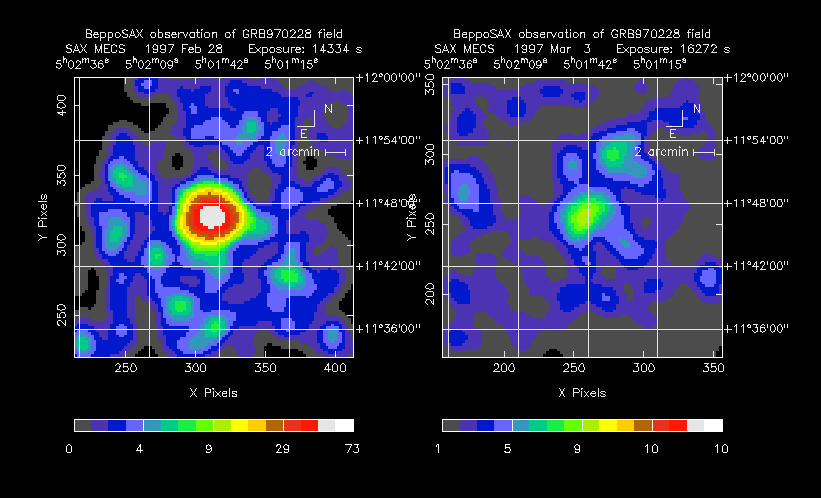
The gamma ray burst, GRB 970228, was discovered simultaneously in the data from the Gamma Ray Burst Monitor and Wide Field Cameras onboard by the team of italian/dutch scientists at 05:00 am on Friday 28th february who continually monitor the satellite data at the Scientific Operations Center in Nuova Telespazio, Rome.
On the basis of experience gained in January (when a similar gamma-ray burst was observed in the constellation of Serpens by BeppoSAX, and studied in detail 16 hours later, in comparison with the previous record for a X-ray observation of about 18 days) the italian scientists responsible for the gamma-ray burst detector onboard the satellite (E. Costa, CNR, and F. Frontera, University of Ferrara), in conjunction with the Mission Scientist (L. Piro, CNR) and the Mission Director (R. C. Butler, ASI), were able to reschedule the satellite observations and point the BeppoSAX narrow field X-ray telescopes in only 8 hours at the gamma-ray burst source. In consequence a X-ray source never before seen was discovered and localized with an accuracy of one hundreth of a degree. The source is actually in the constellation of Orion.
A second follow-up has been performed with narrow field instruments after about 2 days. This second observation has shown a strong drop, about 20 times lower, in the source flux. The pictures taken during the two follow-up observations are shown in the figure below.

The bright source in the field is the new X-ray source
1SAX J0501.7+1146
associated with the Gamma Ray Burst GRB 970228 IAUC 6576 .
SAX J0501.7+1146, has been detected by the MECS and LECS at the same position (R.A. = 5h01m44s, Decl. = +11o46'.7, equinox 2000.0; estimated error radius 50"). This position lies at the edge of the reported BeppoSAX WFC error box (IAUC 6572). The source flux is (2.8 +/- 0.4) x 10E-12 erg cmE-2 sE-1 in the MECS (2-10 keV) and (4.0 +/- 0.6) x 10E-12 erg cmE-2 sE-1 in the LECS (0.5-10 keV). The field was observed again on Mar. 3.734, and a source was detected at a position consistent with the previous one, but at a flux level lower by a factor of 20.